 I’m going to be looking back at history for some new recipes to post here. Commodores have a long history, having been known by several different names over the years. They are fun to make, and of course fun to eat. their modern counterpart are “Fig Newtons”, those cookies that are filled with a fruit paste. Below is one recipe from the fifteenth Century, Called “Rhyschewys“. other names for this dish are Rapyes.
I’m going to be looking back at history for some new recipes to post here. Commodores have a long history, having been known by several different names over the years. They are fun to make, and of course fun to eat. their modern counterpart are “Fig Newtons”, those cookies that are filled with a fruit paste. Below is one recipe from the fifteenth Century, Called “Rhyschewys“. other names for this dish are Rapyes.
Take Fygys, & grynd hem smal in a mortere with a lytil Oyle, & grynd with hym clowys & Maces; & þan take it vppe in-to a vesselle, & cast þer-to Pynez, Saundrys, & Roysonys of Coraunce, & mencyd Datys, Pouder Pepir, Canel, Salt, Safroun; þan take fyne past of flowre an water, Sugre, Safroun, & Salt, & make fayre cakys þer-of; þan rolle þin stuf in þin hond, & couche it in þe cakys, & kyt it, & folde hym as Ruschewys, & frye hem vppe in Oyle; and serue forth hote.
Fun to read, but kind of hard to understand, huh? Well, below is my version of this dish. The recipe above only mentions figs, raisons, dates, and various spices, but since there are so many recipes for this dish, you can use the dried fruits you can find.
Commodores
1/2 cup each of figs, dates, dried apples, prunes, and raisons
1/2 cup red wine
1/4 tsp cinnamon
1/4 tsp nutmeg
1/3 cup honey or white sugar
1 cup water
Grandma’s Pastry Dough
Combine all ingredients except pastry dough. Cook gently over medium heat for about 1/2 hour. It will help if you have a heat diffuser to keep the fruits from scorching. Mixture should be thick, almost stiff. Remove from heat and cool slightly.To the right is how your mixture should look when it come off the stove. 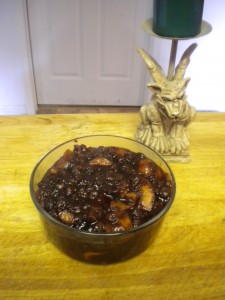 Place into a food processor and pulse until mixture is the consistency of mince pie filling. You should still be able to see individual pieces of fruit, but they will be quite small. Now let’s back up a bit. while your fruit filling is cooking, you can make your GRANDMA’S PASTRY DOUGH! This is, needless to say, my grandmother’s recipe. It is a sure-fire, never miss, easy to make, pie crust. Here we go:
Place into a food processor and pulse until mixture is the consistency of mince pie filling. You should still be able to see individual pieces of fruit, but they will be quite small. Now let’s back up a bit. while your fruit filling is cooking, you can make your GRANDMA’S PASTRY DOUGH! This is, needless to say, my grandmother’s recipe. It is a sure-fire, never miss, easy to make, pie crust. Here we go:
Grandma’s Pastry Dough
1/3 cup BOILING water
2/3 to 3/4 cup shortening
2 cups all-purpose flour
1 tsp salt
1/2 tsp baking powder
Place shortening into a bowl and pour water over it. Using a whisk (my grandmother used a fork, but she had arm muscles of steel), and beating very fast, incorporate the water into the shortening. You should end up with a mixture the consistency of mayonaise. Sift the dry ingredients into the bowl, and stir just until all ingredients hold together. Wrap with plastic wrap and refrigerate.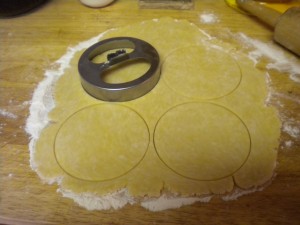
When your pie dough is chilled and your filling is finished, it’s time to assemble. On a floured board, divide your dough in half, and roll out 1/2 of the dough until it’s about 1/8″ thick. Using a 3′ cookie cutter, cut as many rounds as you can. You can collect scraps and re-roll–just remember, the more you work your dough, the tougher it’s going to be. Now, take one circle of dough, place about a good tablesoon of the fruit mixture into the center, and wet the edges. Fold the tart in half, pressing the edges to seal.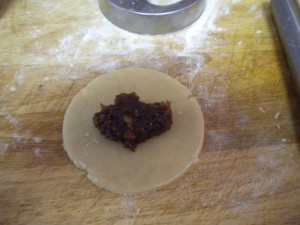
I keep a small cup of water for this purpose where I am working. Be sure to remove the circle from the rolling area before you start the edge wetting process, or you’re going to have a sticky mess on your board. Again, I usually do the sealing process in my hand, to keep things from sticking to my board. Place your tarts on a baking sheet. You can bake them retty close together, as they are not going to expand. When you are ready to bake, brush the surfaces with egg wash (one egg yolk mixed with about one teaspoon of water). 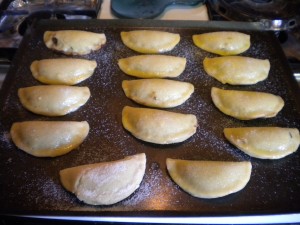
Sprinkle with sugar, and bake for 10 minutes at 425 degrees. Reduce the heat to 350 degrees and bake for another 20 minutes. Allow to cool in the pan. One recipe of pie crust will make about 14 pasties, so you will have some fruit mixture left over to experiment with! You can also make this dish as open-topped tarts, spreading some of the fruit mixture on top of little pie shells. Just remember, the tate of the fruit is intense, so a little goes a long way. This also is a great topping for toast or biscuits, or thinned just a bit would be a great topping for bread pudding. You will find many uses for this remarkable filling. You can also add the pine nuts mentioned in the period recipe–just add them after you have put the mixture through the food processor.
Have fun, add a little history to your life. 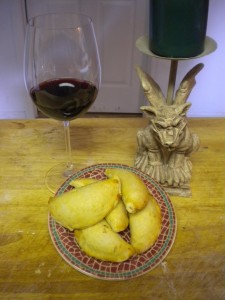
Have them with a nice glass of something slightly sweet, perhaps a sauterne.
See you next time!

Hello, I accidentaly found your blog!I am trying to get ideas for proper writting style for my own website and what you write definitely gave me some ideas. You have a cool website so keep up the good work!
Enjoying the blog. Just wanted to note that I’ve had the privilege of tasting your Commodores in earlier days, and they’re awesome. Wish I had some right now. Oh, and those stuffed dates you used to make. And maybe some spaetzle!